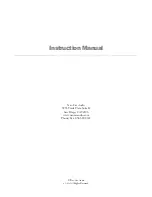
4
The wire routing and concealment depends upon your vehicle
and where the components of your system are placed. The
instructions below address, in general, what panels may need to
be removed and how they typically come off. Often, panels can
be pried up at edges. Screws and retaining clips might also be
present that will require removal (Figure 1). To prevent damage,
always use care when removing panels.
Door Scuff Plate removal
The plates are usually removed by prying up the edges to
release clips. Some vehicles will have screws present which will
need to be removed (Figure 2).
Seat Belt removal
A seat belt may be located on the panel that needs to be
removed. Most seat belt anchor covers pry off. The seat belt
anchor is secured with a large nut or bolt (Figure 3).
Pillar Trimpanel removal
Remove seat belt if present. Remove screw covers, screws
and plastic retaining clips, if present. Pry up edges of panel to
remove (Figures 4 & 5).
Kick panel removal
Look for screws and pry-out retaining clips to remove. Pry out
edges of panel to release and remove (Figure 6).
Routing wire behind dash
Route wire behind dash and secure with plastic wire ties. Be
sure that wire does not interfere with any moving parts to ensure
safe operation of vehicle.
Routing wire for components and power connections
Determine desired locations for each component. Use the most
direct route for wires. Remove panels necessary to route and
conceal wires. Test system before reinstalling panels.
Upper Pillar Trimpanel
Lower Pillar Trimpanel
Seat Belt Cover/Anchor
Door Scuff Plate
Kick panel
FIGURE 2
FIGURE 1
FIGURE 3
FIGURE 4
FIGURE 5
FIGURE 6
Screw w/ Cover
Retaining Clips
The seat belt is
usually secured
with a large hex
head or Torx bolt.
000NAVIG
®
Copyright 2005 Crutchfield Corporation
Panel removal
✔
Make sure seats and seat belts are secured to
manufacturers specifications.
SAFETY CHECK
!























